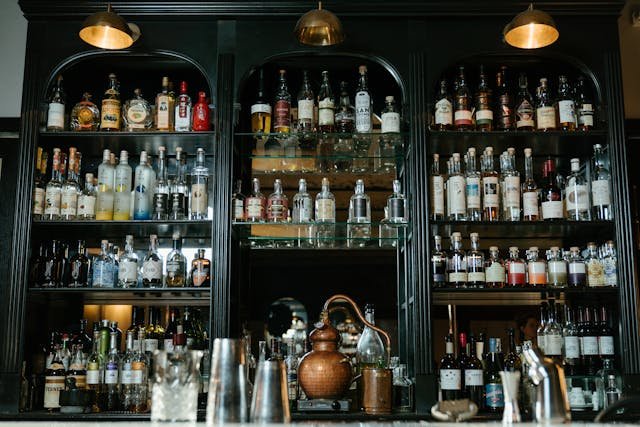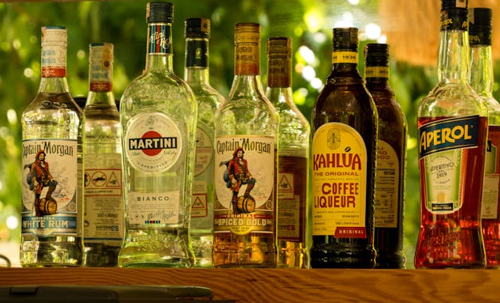Spirits, Liquor, and Liqueurs
In our previous post, we talked about the basics and the 6 steps of making wine. Alright, now it’s time to expand our beverage knowledge and know more about the basics of alcoholic beverages. As you can imagine, alcoholic beverages are not something that has just been discovered; they have been around for a long time, maybe for thousands of years, and they come in many forms. Among the most popular types of alcohol are spirits or liquors and liqueurs.
These beverages come with their own unique flavors, methods of production, and ways of drinking. Understanding the basics of alcoholic beverages, including their types and differences, can help us make better choices when buying or serving alcohol for those who work in the food and beverage industry. In this post, we’ll break down the basics of alcoholic beverages, covering what they are, how they differ from each other, and the most common types of spirits, liquors, and liqueurs we need to know about.
The Basics of Alcoholic Beverages

Before going into the different types, it’s important to understand what alcoholic beverages are and how they’re made. Alcoholic beverages are drinks that contain ethanol, commonly known as alcohol. These drinks are made by fermenting ingredients such as fruits, grains, or vegetables. Fermentation is a natural process where yeast breaks down sugars in the ingredients, turning them into alcohol.
The basics of alcoholic beverages can be divided into three main categories:
- Fermented Beverages: These include drinks like beer, wine, and cider. They have lower alcohol content because the fermentation process only produces a small amount of alcohol.
- Distilled Beverages: These are drinks like spirits, liquor, and liqueurs, which go through a process called distillation. Distillation is a method where the fermented liquid is heated to separate alcohol from the other components, resulting in a stronger alcoholic beverage.
- Fortified Beverages: These are wines or other drinks that have had extra alcohol added to them. Examples include sherry and port wine.
In this post, we’ll focus on the second category—distilled alcoholic beverages—and explore the differences between spirits, liquor, and liqueurs. Understanding these basics will help you enjoy and appreciate these beverages even more.
What Are Spirits?
Spirits are distilled alcoholic drinks that have a high alcohol content, typically between 40% and 50% alcohol by volume (ABV). The term “spirit” is more or less the same as “liquor,” and there isn’t much of a difference, which we’ll discuss later. Spirits are made by fermenting ingredients like grains, fruits, or vegetables and then distilling them to increase the alcohol content.
Some popular types of spirits include:
- Vodka: A clear spirit that is made from grains, potatoes, or sometimes even fruits. It has a neutral flavor and is often used in cocktails.
- Whiskey: Made from fermented grain mash, whiskey has a rich flavor and can be enjoyed neat, on the rocks, or in cocktails. There are different types of whiskey, such as Scotch, bourbon, and rye whiskey, each with unique characteristics.
- Rum: Made from sugarcane or molasses, rum is typically sweet and has a wide range of flavors, from light and smooth to dark and rich.
- Gin: Gin is made by distilling neutral spirits with botanicals, especially juniper berries, giving it a distinct herbal flavor. It is often used in cocktails like gin and tonic.
- Tequila: Made from the blue agave plant, tequila is a spirit that is popular in cocktails like margaritas. It comes in different types, such as blanco, reposado, and añejo.
The basics of alcoholic beverages related to spirits lie in their production process and high alcohol content. Spirits are usually consumed in smaller quantities compared to beer or wine due to their stronger effects.
What Are Liquors?
The term “liquor” is often used interchangeably with “spirit,” but there is a subtle difference. While both terms mean distilled beverages with high alcohol content, “liquor” is more of a general term used to describe any distilled alcoholic beverage. This includes whiskey, vodka, rum, gin, and others.
However, in some regions, the term “liquor” may specifically refer to beverages with a higher alcohol content than beer or wine, which distinguishes them from the fermented varieties of alcohol. When people use the word “liquor,” they often refer to spirits such as whiskey, rum, or vodka.
Liquor is a versatile alcoholic beverage that can be consumed straight, on the rocks, or used as the base for cocktails. It is important to remember that while “liquor” and “spirits” are often used interchangeably, “liquor” can also include beverages like tequila and brandy, which may not always be referred to as “spirits.”
What Are Liqueurs?
Liqueurs are alcoholic beverages made from distilled spirits that are flavored with fruits, herbs, spices, or other sweeteners. Unlike regular spirits, which have a strong, often harsh flavor, liqueurs are much sweeter and are typically consumed in smaller amounts due to their sweetness and lower alcohol content.
The basics of alcoholic beverages involving liqueurs focus on their unique combination of flavors. They are created by infusing spirits with ingredients such as:
- Fruits: Examples include peach schnapps and limoncello, which are made by infusing spirits with the flavors of fruits.
- Herbs and Spices: Herbs like mint and spices like cinnamon are often used to create liqueurs like peppermint schnapps and Jägermeister.
- Nuts and Cream: Some liqueurs use nuts or cream as the base, like amaretto or Baileys Irish Cream.
Liqueurs usually have a lower alcohol content than spirits, typically ranging from 15% to 30% ABV, though some can be stronger. They are often used in cocktails or sipped slowly as a dessert drink. They can be served straight, chilled, or over ice, and are also used to flavor desserts and cakes.
Key Differences Between Liquor, and Liqueurs
Now that we know the basics of alcoholic beverages, it’s important to understand the differences between liquor and liqueurs. While all of these fall under the category of distilled alcoholic beverages, their ingredients, flavors, and alcohol content vary.
- Spirits:
- High alcohol content (usually 40% ABV or more).
- Made from grains, fruits, or vegetables.
- Examples: vodka, whiskey, rum, gin, tequila.
- Typically consumed in small quantities.
- Liquor:
- General term for any distilled alcoholic beverage.
- Includes spirits like whiskey, vodka, rum, gin, tequila.
- Usually stronger than beer or wine, but not necessarily as strong as some spirits.
- Liqueurs:
- Made by infusing distilled spirits with fruits, herbs, spices, or sweeteners.
- Typically sweeter and lower in alcohol content (15% to 30% ABV).
- Examples: Baileys Irish Cream, Grand Marnier, Amaretto.
How Are Spirits, Liquor, and Liqueurs Made?
Understanding the production process for these beverages will help you grasp the basics of alcoholic beverages. The process begins with fermentation, which is the conversion of sugars into alcohol by yeast. Once the fermentation is complete, the beverage is distilled to increase its alcohol content.
- Spirits: After fermentation, the liquid is heated in a still (a special distillation device). The heat causes the alcohol to evaporate, and the vapor is collected and condensed back into a liquid with higher alcohol content. This process is repeated to increase the alcohol concentration. The resulting spirit is then often aged in barrels to enhance its flavor, like whiskey, or bottled directly, like vodka.
- Liquor: Liquor is essentially another term for spirits, and the process of making it is similar. After distillation, liquor may undergo additional steps like aging or blending to create the desired flavor profile.
- Liqueurs: To make liqueurs, distillers begin by making a base spirit, which is then flavored with various ingredients like fruits, herbs, spices, or even chocolate. The spirit is often sweetened with sugar or other syrups to balance the flavors and create a smooth, sweet taste.
How to Drink Spirits, Liquor, and Liqueurs
The basics of alcoholic beverages include not just understanding the types but also how to drink them. Here are some common ways to enjoy spirits, liquor, and liqueurs:
- Straight or Neat: This means drinking the spirit or liquor without any mixers or ice. It’s a popular way to enjoy whiskey, vodka, or rum.
- On the Rocks: Serving the alcohol over ice is a common way to enjoy spirits like whiskey or tequila. The ice helps to chill the drink and slightly dilute it.
- In Cocktails: Both liquor and liqueurs are often used in cocktails. A classic cocktail like a martini uses gin or vodka, while a margarita uses tequila. Liqueurs like Grand Marnier or Baileys Irish Cream are popular in dessert drinks or coffee-based cocktails.
By keeping these basics in mind, you can explore the wide range of alcoholic beverages available today and learn to appreciate the subtle differences in flavor, strength, and style. Whether you’re an a waiter, manager, an experienced drinker, or just starting to explore, understanding the basics of alcoholic beverages will help you make more informed choices or suggestions and increase your self-confidence, as well your general product knowledge.
All the images in this article are from Pixabay (not copyrighted and free for commercial use).






